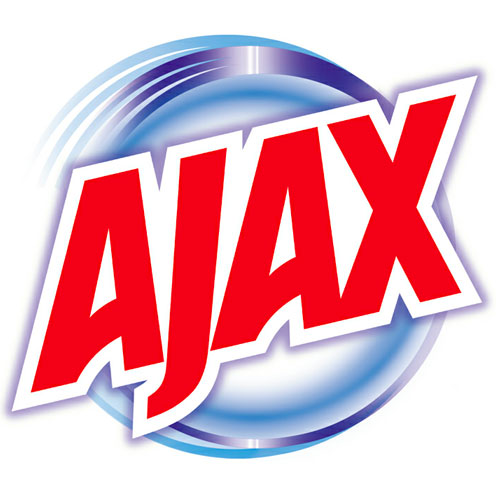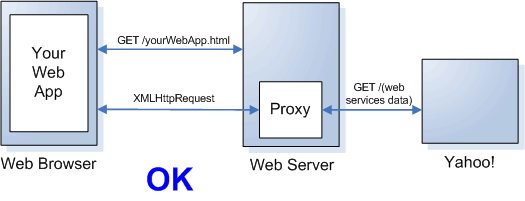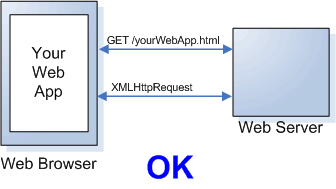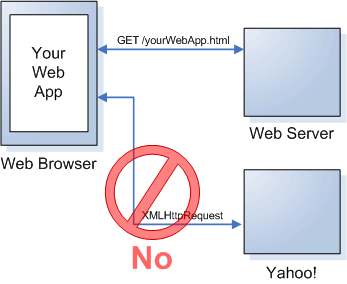Web & Mobile Development JLW288
06.Ajax

Ajax?
-
Acronym: Asynchronous JavaScript and XML
- Term coined in 2005 by Jesse James Garret
- Technology pre-dated 2005 though
-
In Short
- Ajax allows you to do requests to a web server without ever leaving the webpage
-
Example
- Click a link in the navigation of a webpage and see the content get updated dynamically
XMLHttpRequest
-
At the core of Ajax sits a JavaScript API named
XMLHttpRequest(XHR)- It allows you to do a request to a web server
- Calls can be made synchronously and asynchronously
-
Other parts of Ajax are DOM Manipulations and XML
- The data (text) returned by the server is XML-formatted (*)
Example
-
Synchronous example
xhr = new XMLHttpRequest(); xhr.open('GET', 'assets/06/examples/xml.php', false); xhr.send(null); alert('I am outputted once the call has finished loading (5s delay)'); alert(xhr.responseText); -
Asynchronous example
xhr = new XMLHttpRequest(); xhr.onreadystatechange = function() { if (xhr.readyState == 4) { alert(xhr.responseText); } }; xhr.open('GET', 'assets/06/examples/xml.php', true); xhr.send(null); alert('I am outputted immediately (no delay)');
Advantages & Disadvantages
-
Advantages
- No reloads
- Less bandwidth used
- Perceived speed by user
-
Disadvantages
-
URLs “broken”
- No browser history
- No back/forward
- No proper bookmarking
- Search Engines don't index content injected afterwards
- Requires a change in programming attitude
-
URLs “broken”
XHR History
-
XHR's predecessor
IXMLHTTPRequestinvented by Microsoft- Shipped with IE5 (1999!), as part of the
MSXMLLibrary - Available in JS via ActiveX
- Shipped with IE5 (1999!), as part of the
- By 2002 Mozilla had a fully working clone named
XMLHttpRequestin Gecko -
Other browsers also followed
- Safari (2004)
- Opera (2005)
- IE7 (2006)
- W3C started working on a standard in 2008
XHR in IE5/IE6
-
Define your own
XMLHttpRequestObject and return the ActiveX Objectif (typeof XMLHttpRequest == "undefined") XMLHttpRequest = function() { try { return new ActiveXObject("Msxml2.XMLHTTP.6.0"); } catch (e) {} try { return new ActiveXObject("Msxml2.XMLHTTP.3.0"); } catch (e) {} try { return new ActiveXObject("Microsoft.XMLHTTP"); } catch (e) {} throw new Error("This browser does not support XMLHttpRequest"); }; xhr = new XMLHttpRequest(); // rest of your code ....
Same Origin Policy
-
For security reasons, it's only possible to make requests to the same url that serves the page making the request
- It's not possible to call
http://api.ikdoeict.be/fromhttp://www.ikdoeict.be/
- It's not possible to call
- There are ways to circumvent this though (see further)
Ajax Return Types

I've sent you each 300 buckeroos. In the form of a tricky Dick fun bill. Knock yourselves out!
Ajax Return Types
- Everything returned by Ajax is textual data
-
Doesn't mean it's plaintext though
- XML
- HTML
- JavaScript
- JSON
XML
-
Initial usage mostly used XML
- Server must send
Content-Type: text/xmlheader, XHR will automagically parse the returned data as XML
- Server must send
-
Once data is parsed by XHR, walk through the XML nodes tree to get fetch the values you need
- Most of the time a cumbersome work though
- Once XML is parsed, build an HTML string with the data and inject the HTML blog into your document.
XML Example (1)
-
Data returned
<?xml version="1.0" encoding="UTF-8"?> <sample> <course>WMD</course> <lecturers> <lecturer>Bramus Van Damme</lecturer> <lecturer>Davy De Winne</lecturer> </lecturers> </sample>
XML Example (2)
-
JS Implementation
xhr = new XMLHttpRequest(); xhr.onreadystatechange = function() { if (xhr.readyState == 4) { var xml = xhr.responseXML, courseName = xml.getElementsByTagName('course')[0].firstChild.nodeValue, lecturersXml = xml.getElementsByTagName('lecturer'), lecturers = []; console.log(xml); for (var i = 0, len = lecturersXml.length; i < len; i++) { lecturers.push(lecturersXml[i].firstChild.nodeValue); } alert('<p>' + courseName + ' is taught by ' + lecturers.join(' & ') + '</p>'); } }; xhr.open('GET', 'assets/06/examples/xml-nodelay.php', true); xhr.send(null);
HTML
-
Why not let the server prepare a blob of HTML instead of building it after having parse the XML?
-
Data returned
<p>WMD is taught by Davy De Winne & Bramus Van Damme</p> -
JS Implementation
xhr = new XMLHttpRequest(); xhr.onreadystatechange = function() { if (xhr.readyState == 4) { var html = xhr.responseText; alert(html); } }; xhr.open('GET', 'assets/06/examples/html.php', true); xhr.send(null);
-
Data returned
JavaScript
-
Load in a tad of JavaScript, and then
eval()it.-
Data returned
alert('<p>WMD is taught by Davy De Winne & Bramus Van Damme</p>'); -
JS Implementation
xhr = new XMLHttpRequest(); xhr.onreadystatechange = function() { if (xhr.readyState == 4) { var js = xhr.responseText; eval(js); } }; xhr.open('GET', 'assets/06/examples/js.php', true); xhr.send(null);
-
Data returned
-
Beware when using
eval()though:eval()is evil.- But not always: In this case, it is allowed
JavaScript: External Files
-
No need for Ajax if you need to include an external file
var head = document.getElementsByTagName("head")[0], script = document.createElement('script'); script.type = 'text/javascript'; script.src = "/path/to/your/file.js"; head.appendChild(script); -
Does give problems though, as you cannot know when the script has finished loading
- In that case you will need XHR, or — even better — a specific script loader such as RequireJS
JSON
-
JSON = JavaScript Object Notation
- In Short: JSON a JavaScript Object Literal, represented as a string
- Described by Douglas Crockford in 2006 (RFC 4627)
-
Format Example
{ "course": "WMD", "lecturers": [ { "id": 1, "name": "Davy De Winne" }, { "id": 2, "name": "Bramus Van Damme" } ] }
JSON Format
-
JSON = One big Object with keys and values

Figure by json.org - Multiple key-value pairs: comma-delimited
- Keys are of the type
string(double quotes required!) - Values are
string,number,Object,Array,booleanornull
JSON Example
-
Example
xhr = new XMLHttpRequest(); xhr.onreadystatechange = function() { if (xhr.readyState == 4) { var json = JSON.parse(xhr.responseText), lecturers =[]; for (var i = 0, len = json.lecturers.length; i < len; i++) { lecturers.push(json.lecturers[i].name); } alert('<p>' + json.course + ' is taught by ' + lecturers.join(' & ') + '</p>'); } }; xhr.open('GET', 'assets/06/examples/json.php', true); xhr.send(null);-
XHR doesn't parse the string to JSON automagically, you will need to manually parse it using
JSON.parse()(reverse:JSON.stringify())- Older browsers that don't support
JSON.parse()require a library to do the parsing.
- Older browsers that don't support
-
XHR doesn't parse the string to JSON automagically, you will need to manually parse it using
Sidenote: JSON in PHP
What to choose?
-
JSON FTW!
- Easier to work with (both JS & PHP)
- Smaller than XML
- Very readable
- All modern webapp API's output JSON
Ajax: X is for JSON
Ajax in jQuery

Shut up and take my money!
$.ajax()
-
The core function jQuery to make Ajax calls is
$.ajax()- Pass in an object to tell jQuery what to call and how
-
Example
jQuery(document).ready(function($) { $.ajax({ url: 'json.php', type: 'get', dataType: 'json', success: function(data, textStatus, jqXHR) { var lecturers = []; for (var i = 0, len = data.lecturers.length; i < len; i++) { lecturers.push(data.lecturers[i].name); } $('#output').html('<p>' + data.course + ' is taught by ' + lecturers.join(' & ') + '</p>'); }, error : function(jqXHR, textStatus, errorThrown) { console.log(errorThrown); } }); });
$.ajax() Parameters (1)
-
Five basic parameters
url: A string containing the URL to which the request is sent.success: A function to be called if the request succeeds.error: A function to be called if the request fails.type: Type of request to make (POSTorGET). Defaults toGETdataType: Type of data you're expecting back from the server.xmlhtmlscript— Will be interpreted automatically. Only viaGET.json— Will be parsed automatically.jsonptext- (empty → jQuery will guess the type)
$.ajax() Parameters (1)
-
Other interesting parameters
async: Set tofalseif you need synchronous requestsdata: Extra data to be sent to the server (eg. form data)headers: Extra headers to be sent along with the requestusername&password: HTTP Authentication
- Full list of parameters to be found in the jQuery API
Sending data
-
Possible via
dataparameter-
Format is a querystring:
key=value&key=value&key=value
-
Format is a querystring:
-
Manually building a querystring
var values = [ 'firstname=' + encodeURIComponent($('#firstname').val()), 'lastname=' + encodeURIComponent($('#lastname').val()) ]; var queryString = values.join('&'); -
Automatic version:
$.fn.serialize()var queryString = $('#signupform').serialize(); -
Also possible: an Object
{key : "value"}
$.ajax() alternative syntax
-
jQuery1.5 introduced deferreds which allow this:
jQuery(document).ready(function($) { $.ajax({ url: 'json.php', type: 'get', dataType: 'json' }).success(function(data, textStatus, jqXHR) { var lecturers = []; for (var i = 0, len = data.lecturers.length; i < len; i++) { lecturers.push(data.lecturers[i].name); } $('#output').html('<p>' + data.course + ' is taught by ' + lecturers.join(' & ') + '</p>'); }).error(function(jqXHR, textStatus, errorThrown) { console.log(errorThrown); }); });- Instead of passsing
succesanderrorfunctions in the call, you hook them onto the request
- Instead of passsing
Sidenote: Deferreds
-
Deferreds are awesome!
- When creating the ajax call, you get back a promise
- The
successanderrorfunctions are bound to the promise - When the ajax call is completed, the promise is resolved and the attached functions are executed
- You can create your own deferreds in jQuery
- jQuery has an easy
$.when(deferred).then(function)shorthand⚑
Basic Shorthands
Basic Shorthands: $.get()
-
Example
jQuery(document).ready(function($) { $.get('json.php', function(data, textStatus, jqXHR) { var lecturers = []; for (var i = 0, len = data.lecturers.length; i < len; i++) { lecturers.push(data.lecturers[i].name); } $('#output').html('<p>' + data.course + ' is taught by ' + lecturers.join(' & ') + '</p>'); }, 'json'); }); -
Possible to pass in extra data
jQuery(document).ready(function($) { $.get('json.php', { key: "value" }, function(data, textStatus, jqXHR) { // ... }, 'json'); });
Basic Shorthands: $.post()
-
Same syntax as
$.get()jQuery(document).ready(function($) { $.post('json.php', { key: "value" }, function(data, textStatus, jqXHR) { // ... }, 'json'); });
Specific Shorthands
-
jQuery also sports other shorthands for commonly used actions
- $.fn.load() — Load a piece of HTML into an element
- $.getScript() — Load a piece of JS and run it
- $.getJSON() — Load in a piece of JSON
- These functions only work using
GET
Specific Shorthands: $.fn.load()
-
Example
jQuery(document).ready(function($) { $('#output').load('html.php'); }); - Also possible to send extra data and hook a success function (see jQuery API)
Specific Shorthands: $.getScript()
-
Example
jQuery(document).ready(function($) { $.getScript('js.php'); }); - Also possible to send extra data and hook a success function (see jQuery API)
Specific Shorthands: $.getJSON()
-
Example
jQuery(document).ready(function($) { $.getJSON('json.php', function(data, textStatus, jqXHR) { var lecturers = []; for (var i = 0, len = data.lecturers.length; i < len; i++) { lecturers.push(data.lecturers[i].name); } $('#output').html('<p>' + data.course + ' is taught by ' + lecturers.join(' & ') + '</p>'); }); }); - Also possible to send extra data (see jQuery API)
Sidenote: Multiple Calls
-
In some cases, you'll need to do 2 requests before you have all needed data
-
Oldskool solution: chain calls
- Invoke call #1
successfunction of call #1 will invoke call #2successfunction of call #2 will populate the page
-
Better solution: use the
forcedeferredsfunction doAjax() { return $.get('foo.htm'); } function doMoreAjax() { return $.get('bar.htm'); } $.when(doAjax(), doMoreAjax()) .then(function(){ console.log('I am fired once BOTH ajax requests have completed!'); }).fail(function(){ console.log('I am fired if one or more requests failed'); });
-
Oldskool solution: chain calls
What to use?
-
Shorthands allowed, yet if you want to have full control use
$.ajax() - Use deferreds when requiring multiple resources
Ajax Challenges

What's this? Hermes Conrad is closing the gap. He's limbo-ed out of retirement and straight into my heart!
Ajax Challenges
-
When using Ajax, some usability challenges are faced
- How does the visitor know the site isn't broken but data is loading?
- The back and previous button (and thus bookmarking of specific content) is broken.
-
As a developer, you're also facing some technical challenges
- Cross-Domain Communication
- Working with authentication
Ajax Challenges
I. User feedback
User Feedback
-
Always give the user feedback that something is loading.
- Textual feedback — viz. “loading”
-
Spinners (gifs)





-
Generate spinners at ajaxload.info
- Also possible with CSS3 nowadays #lmgtfy
User Feedback: Example
-
Show spinner when request is being made, hide spinner when it's done.
<img src="spinner.gif" style="display: none;" id="spinner"> <div id="output"></div> <script src="js/jquery-1.7.1.min.js"></script> <script> jQuery(document).ready(function($) { $('#spinner').show(); $('#output').load('html-delay.php', function() { $('#spinner').hide(); }); }); </script> -
Additionally, when loading data after pressing a button
- Disable the button to prevent the user from clicking it twice
- Show spinner
Ajax Challenges
II. Unbreaking History
History: Hashes
- When building a single page interface (think GMail, or even this presentation), you must enable a way to directly link to a certain part/state of the page.
-
Oldskool solution: hashbang URLs
- Change the
hashof thewindow.location - Listen for the
hashchangeevent to detect wheter a user has clicked the back/forward button and re-apply the state - When loading the page, check for a
hashand re-apply the state
- Change the
- But really, don't use hashbang URLs
History: pushState
-
HTML5 introduced
history.pushState()andhistory.replaceState()which allow you to manipulate the browserhistoryobject-
history.pushState()= add new entry onto history object -
history.replaceState()= replace the current entry in history object
-
-
Whenever user presses back/forward, browser will trigger a
popstateevent
History: pushState Syntax
-
history.pushState()var stateObj = { foo: "bar" }; history.pushState(stateObj, "page 2", "bar.html");stateObj— An object you want to associate with the history entry. Will be returned whenpopstateis triggeredtitle— Title you wish to link to the history entry (ingored!)url— URL to show in the address bar (optional)
-
popstateeventwindow.addEventListener('popstate', function(stateObj) { console.log(stateObj); // { foo: "bar" } });
History: pushState Demo (1)
-
Without
history.pushState()
Show demo →<ul> <li><a href="#" id="link_1">link 1</a></li> <li><a href="#" id="link_2">link 2</a></li> <li><a href="#" id="link_3">link 3</a></li> <li><a href="#" id="link_4">link 4</a></li> </ul> <script src="js/jquery-1.7.1.min.js"></script> <script> jQuery(document).ready(function($) { $('ul').on('click', 'a', function(e) { e.preventDefault(); $('ul a').css('background', 'inherit'); $(this).css('background', '#FF9'); }); }); </script>
History: pushState Demo (2)
-
With
history.pushState()
Show demo →jQuery(document).ready(function($) { $('ul').on('click', 'a', function(e) { e.preventDefault(); $('ul a').css('background', 'inherit'); $(this).css('background', '#FF9'); history.pushState({'id':this.id}, 'clicked ' + this.id, ''); }); $(window).on('popstate', function(e) { $('ul a').css('background', 'inherit'); if (e.originalEvent.state && e.originalEvent.state.id) { $('#' + e.originalEvent.state.id).css('background', '#FF9'); } }); });
Ajax Challenges
III. Cross-Domain
Cross-Domain
- Cross-Domain XHR Requests are not allowed
-
Three possible solutions to bypasssing this problem
- Proxy Script
- JSONP
- CORS (XHR2)
Cross-Domain: Proxy Script (1)
-
Put a little (PHP) Script on your own webserver which fetches the data from the remote server

Figure by Yahoo!
Cross-Domain: Proxy Script (2)
-
Dataflow
- Client calls
http://site.com/proxy.php?route=ajax%2fuser%2flogin%3fparam_a%3d1%26param_b%3d2 proxy.phpfetches data fromhttp://othersite.com/ajax/user/login?param_a=1¶m_b=2proxy.phpoutputs fetched data
- Client calls
-
proxy.phpImplementation- From scratch with curl
- With the help of PHP HTTP classes such as RESTRequest/Guzzle
- Prefab with projects like ajax-proxy
Cross-Domain: JSONP (1)
- Short for JSON with Padding
-
Exploits the fact that we can make requests to JavaScript code on other servers
-
Return JSON wrapped inside a callback function instead of just JSON
{"firstname" : "forrest", "lastname" : "gump"}callbackFunction({"firstname" : "forrest", "lastname" : "gump"}) - The returned data will be
eval()'d, thus the callback function — which will parse the JSONString to JSON — will be executed
-
Return JSON wrapped inside a callback function instead of just JSON
-
The name of the callback function is passed as an URL parameter, by convention
callbackorjsonphttp://othersite.com/ajax/user/login?param_a=1&callback=callbackFunction
Cross-Domain: JSONP (2)
-
In jQuery, working with JSONP is very easy
- Specify the
dataTypeto beingjsonp- jQuery will automagically define callback function
- jQuery will automagically add callback parameter to the request url
$.ajax({ url: 'jsonp.php', type: 'get', dataType: 'jsonp', success: function(data, textStatus, jqXHR) { // ... } });
- Specify the
-
JSONP downsides:
- Only works with
GET - Can be harmful because external code is
eval()'d
- Only works with
Cross-Domain: CORS
- Short for Cross-Origin Resource Sharing
-
New feature in
XMLHttpRequest2 -
Server can specify which domains may call it via a header
-
In PHP:
header('Access-Control-Allow-Origin: othersite.com'); - Set to
*to allow calls from any domain
-
In PHP:
-
Once CORS is enabled, you can use the remote resource as you'd use a local resource.
- Not limited to
GET
- Not limited to
-
oldIE + IE9 Note
- To mimic CORS in IE8&9, you can use a little helper function
Sidenote: XHR2
-
XHR on steroids
- Specify response format natively
- Send binary data (file uploads!)
- Cross Origin Resource Sharing
- More info on html5rocks.com and MDN
- Can we use it already? It looks like it :-)
Sidenote: App Authentication
-
When working with public API's, you'll sometimes need to authenticate your app with an API key
-
Some apps accept it as an URL parameter
http://othersite.com/ajax/user/login?param_a=1&apikey=yourapikey -
Some apps require it sent in via a custom header
$.ajax({ url: 'json.php', dataType: 'json', header : { 'X-Api-Key' : 'yourapikey' }, success: function(data, textStatus, jqXHR) { // ... } });
-
Some apps accept it as an URL parameter
- API keys are used for logging, rate limiting and usage analysis (and eventual blocking)
Questions?
Sources
- http://en.wikipedia.org/wiki/XMLHttpRequest
- http://api.jquery.com/jQuery.ajax/
- http://stage.learn.jquery.com/ajax/
- http://www.jquery-tutorial.net/ajax/introduction/
- http://net.tutsplus.com/tutorials/javascript-ajax/5-ways-to-make-ajax-calls-with-jquery/
- http://www.html5rocks.com/en/tutorials/cors/
- http://www.html5rocks.com/en/tutorials/file/xhr2/
- http://www.kendoui.com/blogs/teamblog/posts/11-10-04/using_cors_with_all_modern_browsers.aspx
- http://www.html5rocks.com/en/tutorials/cors/
- http://www.erichynds.com/jquery/using-deferreds-in-jquery/
- http://intridea.com/posts/fun-with-jquery-deferred
- https://developer.mozilla.org/en/DOM/Manipulating_the_browser_history
- http://slides.html5rocks.com/#history-api
- http://robertnyman.com/html5/history-api/history-api.html
- http://developer.yahoo.com/javascript/howto-proxy.html
- http://en.wikipedia.org/wiki/JSON
- http://en.wikipedia.org/wiki/JSONP

